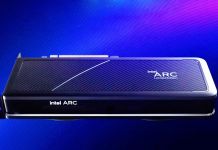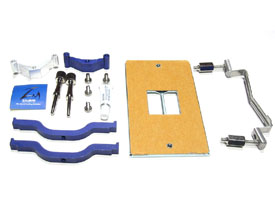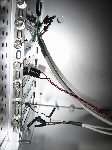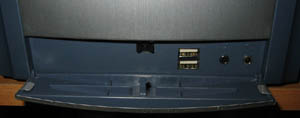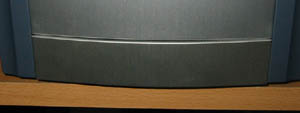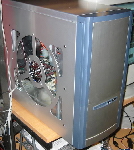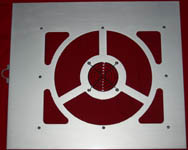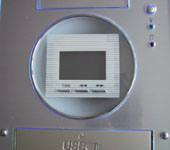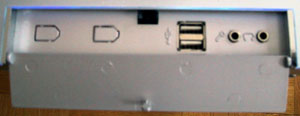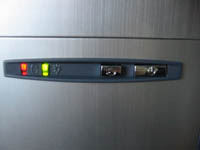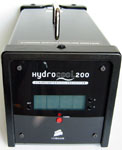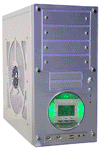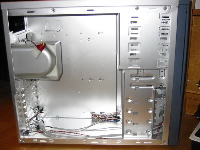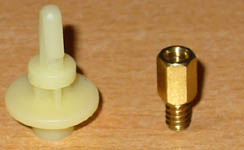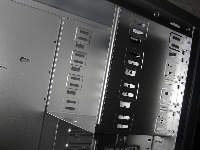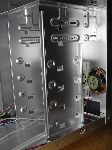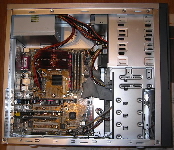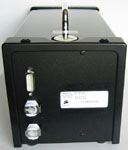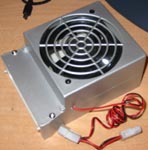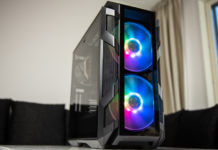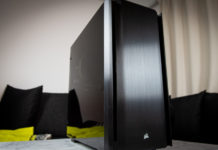Today we will look at two cases from a new manufacturer on the European market, but which is well establishes in China, namely SkyHawk. The two models are named PSR-5602+W andPSR-4698D7+W.
More and more
manufacturers com with aluminum cases for the regular user, something that
was only available for the extreme user a time ago. Lian-Li is a well known
brand which makes aluminum cases, but they and many other manufacturers of
aluminum cases has one weakness in common: the price. The regular user might
think that 2000 SEK is a pretty high price to pay for a case, just to get
it in another material.
The reason to upgrade from steel/plastic to aluminum are many. The main argument
is that it dissipates heat from the case much better, something that actually
is very true. The weight is nice, aluminum is much lighter than the same volume
of steel. Furthermore it looks very good, brushed aluminum has become a popular
finish. Today we will look at two cases from a new manufacturer on the European
market, but which is well establishes in China, namely SkyHawk. The two models
are named PSR-5602+W andPSR-4698D7+W.
|
Specifications:
SkyHawk PSR-5602+W & PSR-4698D7+W |
|
|
Case
|
|
| Case type |
ATX
midi tower |
| Material |
Aluminium
|
| Net weight |
4.4
Kg |
| Measures (Height, Width, Depth) |
410x200x485mm
|
| No. external 5,25″ |
4 |
| No. external 3,5″ |
2
|
| No. internal 3,5″ |
4
|
| No. fan slots |
2x80mm
+ 1x60mm |
| Other 5602 |
Window |
| Other 4698D7 |
Window
in the side, 2 USB 2.0 ports, mic input and headphone output at front, thumb screws for the most. LCD display in the front’s lower part. |
| Power supply |
No
|
The specifications
don’t reveal much except the weights which are kind of low for midi towers.
This is of course because of the material they are made of. The cooling looks
normal on the paper, but it’s much worse in reality, which we will look at later.
They don’t come with a power supply, but that is not rare when it comes to aluminium
cases.
| Price/Availability |
The price is
around 1200 SEK for both the cases which is very cheap for being aluminium
cases. The manufacturer is not very known in Sweden, but the products are
available (together with some other models in the same price class) at Gtek.net
for 1195 SEK/~149$ (Exchange rates).
Remember that the cases don’t come with a power supply. The price almost feels
too cheap for an aluminium case of this quality, which we will see later in
this review. The 4698D7-version is of bigger value because of its LCD display
in the front. Whether it’s useful or not will show later in the review. It
doesn’t feel like the availability negates the grades much, since the products
are available at a well known online dealer.
|
Price/Availability
|
||
| We compare the price against similar products and also the availability among retailers. |
|
|
It’s kind of
stingy with accessories included with the case, but the most important ones
are there: Screws, a small manual, a standard ATX plate and a little adapter
for power LEDs. The adapter is a small smart construction which enables you
to connect the power LED to the mainboard whether it have to pins or three.
The screws are dimensioned as they are supposed to, and you get motherboard
spacers in both metal and plastic. The manual only describes the USB cables,
something that is also printed on the cables. A nice surprise is that not
only the case’s both sides are seated with thumb screws, but all the expansion
plates as well. This makes it very easy to, for example, change a card on
a LAN or similar.
|
|
|
Behind a door
on the front we can find two USB 2.0 connections, mic input and headphone
output. Though these requires a motherboard with support for these functions,
in short there will be a description on how you connect the headphone output
and mic input to a regular sound card. The USB cables look like a backbone
cabling, and are impossible to connect if you don’t have the manual to your
motherboard in hand. There are two cables per USB contact: voltage, earth
and two signal cables. If you connect them wrong you might burn the unit you
connect, to don’t take your chances on it. Even though this is quite regular
it is in no way standard, and a nice detail.
|
|
|
|
|
On the left side
you can find a window with a little different shape, and a hole for a fan
in the middle. The plexiglass is mounted with a couple of screws/rivets which
makes it relatively easy to change its colour, if you would want that. The
aluminium is nicely brushed, and the case looks a lot more expensive than
it is. It is important to leave a clean inside of the case if you have a window
of this size, no ugly cables here :). There is also little loops on the backside
of the sidepanels, that without it showing too much, makes it easy to remove
the sides of the case.
|
|
|
|
Accessories/features:
PSR-5602+W |
||
| We look at the number of and usefulness of the accessories and integrated features. |
|
|
|
4698D7 uses the
same standards as 5602 except when it comes to visual appearance. What differs
between them in accessories is the display which we mentioned earlier. The
display has three functions: indicator for HDD-activity, temperature and clock.
What we found strange was that the temperature meter was designed to fit your
primary hard drive. The first thing you thought when you looked at the sensor
was of course that it would measure the temperature of the CPU, not the hard
drive. The sensor isn’t even designed for measuring CPU temperatures. To mount
it under the CPU as you do with other sensors is not to think about, and to
mount it directly on, or beside, the core is not a good idea either, though
it might come close enough to give a relatively good temperature indication,
about the same as the BIOS and other various programs reports.
To have a clock on the LCD display might be good for some but it’s hardly
something that impresses much. HDD activity is already shown in the LED in
the case next to the power button, more than that is not really necessary.
In other words, when installed as supposed to (with the temperature sensor
on the hard drive) this LCD display hardly fills any major function. If you
on the other hand mount the sensor on/next to the CPU or in some other vital
place, things might get more interesting.
|
|
The door in the
lower front can also be found on the 4698D7 despite the esthetic differences.
The difference here though is that this case is prepared for FireWire ports.
But since the connection-"unit" required is special designed and
SkyHawk themselves have not delivered the connection panel for FireWire, the
two holes are there just teasing you. The mainboard we installed had support
for FireWire but since the connection panel is to be mounted in a PCI slot
we had to use that instead. We could probably have modded it to fit this case
but it would have been too much. No matter what, it’s no minus that the possibility
is there and if you want to mess with it on your own it can be done even if
SkyHawk don’t deliver the accessories that are needed.
|
|
|
|
|
Other than this
the two cases are identical both on the inside and outside, what differs is
simply the front. The LCD display and possibilities for FireWire doesn’t affect
the grade more than half a point because of the relatively limited functionality.
|
Accessories/features:
PSR-4698D7+W |
||
| We look at the number of and usefulness of the accessories and integrated features. |
|
|
The case is fully
made out of aluminium, except for the framework which actually is made out
of blue plastic. The colours match each other very good, and takes away the
impression of too much aluminium. Some cases simply looks dull when made completely
out of aluminium. On the front we find the four standard components, light
diodes for hard disc activity and power, reset and power buttons. The power
indicator is green as usual, and the HD LED is dark red. I would like to apologize
for some of the pictures, but it is hard to take pictures of something that
shines when the flash either blinds the whole picture or does not give any
light at all.
|
|
|
The aluminium
is brushed in lines, which breaks the monotony in a nice way and makes the
case look more "alive". The window fits the design really good,
excellent for all those those do not wish to do all the work a nice mod requires,
just insert a CCFL-tube and it is finished. The blue plastic does not disturb
at all, but leaves an impression of stability. The door in the front, which
covers the 5.25-units, is a nice solution if you do not want to repaint them
in a matching colour. I think the big door makes the case look a little boring,
some kind of alteration in the design would have given the front a better
view.
|
|
|
|
Design
|
||
| We take a closer look at the functional and esthetic design of the case. Ease of use is a very important factor. |
|
|
|
Once again it
is the front that differs the two from each other. 4698D7 is somewhat more
clean, at least until you install your 5.25 units. The classic light gray
plastic breaks the continuity and together with the brushed aluminium they
almost look dirty. Unfortunately it is not that easy to repaint the units
to make them fit, but please mail us if you find a tin with "brushed
aluminium"-paint at your local paint shop.
A stealth mod could have worked, but if you have a CD/DVD with slot-in and
a floppy drive it would not have been that beautiful anyway, without a lot
of work.
|
|
The LCD display
is a less good thing what esthetics concerns, and if you decide to remove
it the hole that is left is not too beautiful either. SkyHawk should have
solved this in a better way. Once you turn on the computer it looks a little
better as the display starts to flash in different colours. Still, this is
quite annoying and luckily it is possible to lock one of the colours, and
we chose dark blue which turned out rather good. As we don not know how to
show this better we let you see this picture that GTEK has one their web site:
|
|
I think it is
a failure, but if you lock the dark blue colour it looks ok. (As you can see
GTEK’s case is not identical to ours, but I guess we have got an updated version).
If you remove the display and the plexiglass that covers it, you get a nice
hole (yet ugly) for air flow. The first thing that hit you is that you could
put a 120 mm fan on the inside, but unfortunately the screw holes are located
a little too tight to make it possible. An 80 mm fan works nice though.
The tiny door at the bottom for inputs and outputs breaks the colour and feels
very plastic, but as it is very relatively small it does not hurt too much.
|
Design
|
||
| We take a closer look at the functional and esthetic design of the case. Ease of use is a very important factor. |
|
|
The installation
did partially work fine. There are a number of different sets of holes for
the mainboard, and most mainboards are easy to mount, both with screws and
small plastic things. Note that there are four small plastic pieces, intended
for larger boards, which are put into the outer set of holes. Squeeze them
into the incisions to the appropriate holes. No slide-out mainboard tray was
included, but we had no problems attaching the board, there was on the contrary
a lot of space.
|
|
|
The ATX panel
was easy to attach, and even though the thin aluminum was a little deformed
it was a simple thing to correct it. The hard drives got on place relatively
easy, but you had to work a little to get the screw holes in the right position.
Unfortunately, this case has no detachable drive cages, which many other cases
have, but on the other hand you get a lot more drive bays to play around with.
The HD’s are attached with four screws, and what HD’s concerns, the more screws
the better heat transmits to the rest of the case.
The 5.25 units was a completely different thing. You had to use a slight piece
of violence to get them in place and to remove the front panels. There are
no rails to attach the the units with, something that at least I am used to.
However, this is not available on more expensive aluminum cases either, so
maybe it is possible that aluminum is too soft for snap-locks, and requires
screws instead. It is possible to use up to 8 screws when mounting 5.25 units,
but that seems rather useless as we not planning to drop the computer from
great heights or travel to earthquake areas.
|
|
|
The fit is far
away from perfect in this case. The front door on 5602 makes a scratching
noise when you open it, but that’s not a big deal. I couldn’t find any sharp
edges, and the case seems to be designed in a way specifically to avoid that.
These cases are identical on the inside except for the LCD display which is
available on 4698D7. Just a sensor and another link for HHD-LED should be
connected and that was naturally very easy. Especially if you do as the manufacturer
says and put the sensor on the hard drive (which we did not do, of course).
This results in a identical grade for both cases as the details that make
them differ don not affect the installation except for a few extra seconds
with 4698D7.
|
|
|
|
User
friendliness/installation |
||
| We take a closer look at the functional and esthetic design of the barebone. Ease of use is a very important factor. |
|
|
Even though this
case is good in most aspects, the cooling is something that really needs improving.
The specifications seems OK, one 80mm in the front, one 80mm in the side panel,
one 80mm at the back. On top of this another fan is included, one that is
mounted in an air tunnel right above the cpu-fan, this seems to be a good
way to exhaust abundant air. Reality, however, is something completely different.
The front-mounted fan on the 5602 doesn’t have any blowhole so basically what
it does is shuffle around air in the harddrive area. Of course this is good
for the life expectancy of the harddrives but the fan just circulate the same
hot air inside the case. The side-mounted fan is the only reasonable place
to inhale fresh air. The included screws are only long enough to hold the
fan grill, if you want to mount the fan you need to buy new longer ones, not
a big job but nothing you’d want to do. In a few of those 80mm fans we tested
the holes were small enough to mount with the screws included with the case
but that’s hard to tell in advance. When it comes to the blowhole at the back
there are some cons, for example the use of a 60mm fan there. First of all,
its not easy to find a good 60mm fan that’s a 80mm, and second it gives less
airflow per noise level. The ones that transport enough air are often very
loud. The included fan in the mentioned air tunnel is impractical in every
way, it didn’t affect the temperature of the cpu at all, it was very loud
and didn’t transport very much air.
4698D7 differs
some on account of the removable LCD-display that open up and gives room for
airflow in the front. But since this would be next to modding of the case
and not very good-looking we will not take it into account. But for those
of you who have the urge the opportunity exists. One problem with this box
is that you connect an adapter at the ATX-connector of the mainboard. (the
adapter feeds power to the LCD). This adapter was unfortunately blocking the
60mm hole and made installation of a fan there impossible.
|
|
|
|
Cooling
|
||
|
We look |
|
|
The case is all
in all clean cut and nice but there are some details that should be noticed.
The most important of these are space, you shouldn’t have to use force to
install units or open the front panels. Another important detail is cooling,
the chassis of today you need 80mm fans both front and back. A 60mm back mounted
fan, and a side mounted 80mm simply will not suffice. The screws for the side
mounted fan feel like a trifle but it ought to be corrected.
The advantages are numerous as well, first and foremost I’m thinking of the
stylish and neat design. Without being too flashy they have constructed a
chassi that definitely doesn’t look boring, the pre-mounted window is a very
stylish detail which will attract most users who don’t know how nor have the
time to mount one of their own. The number of internal 3.5" slots is
a plus since very few cases in this size have many slots. The little details
are nice with this case, I’m not thinking of the thumbscrews alone but of
the front mounted outlets for example, even if it’s not that unusual it’s
far from standard. The price is another big plus, 1200 SEK including VAT,
that’s not a bad price for an aluminum case.
|
SkyHawk
PSR-5602+W: 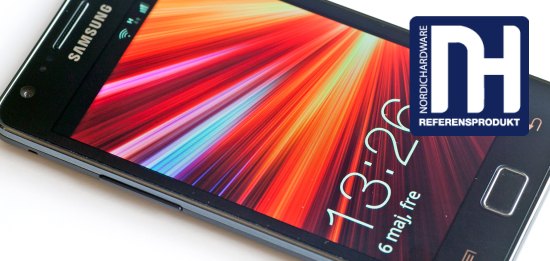 |
|
Pros: Cons: |
| Price/Availability: | 9.0 |
| Accessories/Features |
7.0
|
| Design: | 8.0 |
| User friendliness/Installation: | 7.5 |
| Cooling: | 4.5 |
| Final grade: |
|
Since the two
cases are at some extend very much alike we spare ourselves from running through
everything once more. The things that seperated the two were; design of the
front, LCD-display, and less cooling.
The LCD-display
makes for a better final grade but the differences are few. It’s a pity about
the cooling possibilities with both cases. Sure, it’s nice with a cool case
but with an aluminum chassis in this class we expected at least standard cooling
possibilities.
|
SkyHawk
PSR-4698D7+W:  |
|
Pros: Cons: |
| Price/Availability: | 9.0 |
| Accessories/Features |
7.5
|
| Design: | 8.0 |
| User friendliness/Installation: | 7.5 |
| Cooling: | 4.5 |
| Final grade : |
|


